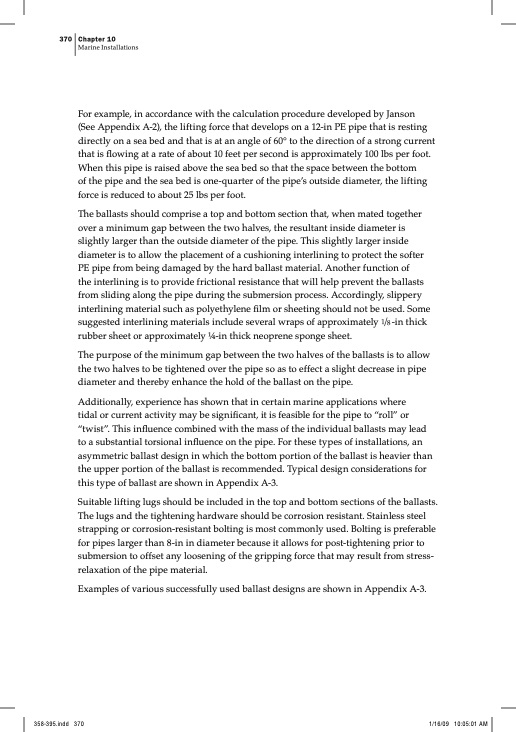
PDF Publication Title:
Text from PDF Page: 012
370 Chapter 10 Marine Installations For example, in accordance with the calculation procedure developed by Janson (See Appendix A-2), the lifting force that develops on a 12-in PE pipe that is resting directly on a sea bed and that is at an angle of 60° to the direction of a strong current that is flowing at a rate of about 10 feet per second is approximately 100 lbs per foot. When this pipe is raised above the sea bed so that the space between the bottom of the pipe and the sea bed is one-quarter of the pipe’s outside diameter, the lifting force is reduced to about 25 lbs per foot. The ballasts should comprise a top and bottom section that, when mated together over a minimum gap between the two halves, the resultant inside diameter is slightly larger than the outside diameter of the pipe. This slightly larger inside diameter is to allow the placement of a cushioning interlining to protect the softer PE pipe from being damaged by the hard ballast material. Another function of the interlining is to provide frictional resistance that will help prevent the ballasts from sliding along the pipe during the submersion process. Accordingly, slippery interlining material such as polyethylene film or sheeting should not be used. Some suggested interlining materials include several wraps of approximately 1/8 -in thick rubber sheet or approximately 1⁄4-in thick neoprene sponge sheet. The purpose of the minimum gap between the two halves of the ballasts is to allow the two halves to be tightened over the pipe so as to effect a slight decrease in pipe diameter and thereby enhance the hold of the ballast on the pipe. Additionally, experience has shown that in certain marine applications where tidal or current activity may be significant, it is feasible for the pipe to “roll” or “twist”. This influence combined with the mass of the individual ballasts may lead to a substantial torsional influence on the pipe. For these types of installations, an asymmetric ballast design in which the bottom portion of the ballast is heavier than the upper portion of the ballast is recommended. Typical design considerations for this type of ballast are shown in Appendix A-3. Suitable lifting lugs should be included in the top and bottom sections of the ballasts. The lugs and the tightening hardware should be corrosion resistant. Stainless steel strapping or corrosion-resistant bolting is most commonly used. Bolting is preferable for pipes larger than 8-in in diameter because it allows for post-tightening prior to submersion to offset any loosening of the gripping force that may result from stress- relaxation of the pipe material. Examples of various successfully used ballast designs are shown in Appendix A-3.PDF Image | Marine Installations PE

PDF Search Title:
Marine Installations PEOriginal File Name Searched:
PE-Marine-Installations.pdfDIY PDF Search: Google It | Yahoo | Bing
Development of a solar powered Electric Ship The Electricship website originally started off as a project to develop a comprehensive renewable, affordable, modular electric ship... More Info
Modular Boat Hull Composite The case for a unsinkable, modular composite hybrid boat hull... More Info
MS Burgenstock Hybrid Electric Catamaran Lake Lucerne Unique shuttle servicing Lucerne to the Burgenstock Resort... More Info
Ground Power Unit GPU Powered by Lithium Ion Batteries The goal of the Ground Power Unit is to provide a readily accessible, modular, ready-to-power solution for remote power... More Info
| CONTACT TEL: 608-238-6001 Email: greg@electricship.com | RSS | AMP |